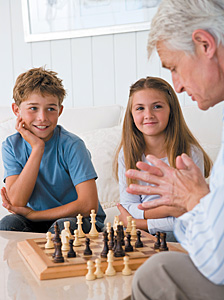We all tell our patients that exercise is good for their bodies; but do we tell them the same is true for their brain? Just like any other muscle, the brain can get in shape, be strengthened and developed with use – exercise.
The human brain is made up of nerve cells called neurons; they are connected by synapses, which transport information from one neuron to the other. Just like other muscles and organs, the brain changes with age; synapses fire more slowly, some cells die off and the overall mass of the organ shrinks. However, advances in brain imaging and neuroscience, coupled with studies of twins, have shown that not all change is genetically predetermined or inevitable.
This new understanding of the brain and its response to exercise has created an entire new industry based on a word coined by Drs. Katz and Rubin in 1999 called neurobics. This is a term for mental exercises which are used to increase the range of mental motion by activating different parts of the brain. But while neurobics involves a specific set of exercises, studies have shown that any exercising of the brain may not only stave off brain degeneration, but in many cases also reverse memory loss and improve mental agility.
Infants to Toddlers
| Maintain Your Brain: Ideas for Patients
• Don't be isolated. Get involved in groups or social organizations and participate in stimulating conversation that strengthens family and friendships. • Develop physical activities. Walk, ride a bicycle, dance, do aerobic exercises. • Learn something new. Take a class in something that interests you, read and write every day; learn a second language, learn sign language, learn to play a musical instrument. • Games are great. Play board games or brain exercising video games; do crossword puzzles or challenging word and number games. • Stimulate the senses: travel, learn to relax with music, meditate, do yoga and tai chi. • Feed the brain wisely. Eat more salmon, sardines, herring, walnuts and unsalted nuts; increase your intake of vitamins C and E, and fruits and vegetables; decrease your intake of processed food and fast foods; make it a priority to sit down with others for at least one meal a day. • Get enough sleep every night. |
Many parents express delight in what they consider an early or advanced milestone when a child goes straight from rolling over to walking. However, the act of learning to crawl develops synapses that cross the hemispheres in the brain. Crawling requires the movement of the right arm with the left leg and vice versa. This motion or "cross-crawling" is a physical exercise that activates the nerve cells in the brain and stimulates them to create synapses or neurological pathways between the left and right side of the brain. Crawling is as vital in stimulating brain growth as it is in helping a child be mobile; in fact, it's more important.
Studies have found that not only can avoiding crawling cause learning difficulties in reading, writing and comprehension, but even speech can be affected if the crawling stage of development is skipped. Thus, if an infant has gone from rolling over to using objects to creep along in a standing position, it's important to take the child down from the furniture and encourage them to crawl.
Children and Pre-Adolescents
Obviously, children and pre-adolescents are going to benefit from brain games that encourage them to actually use their brains; for instance, memory games in which the children try to turn over one card at a time and match the cards. These games have been around for years but are still beneficial. Puzzles, card games and even riddles can be equally valuable.
This age group will also benefit in the same way from physical games. Research has shown that children in this age group can best exercise their brain by playing physical games that force them to "cross the midline" and engage both sides of their bodies simultaneously. Crossing the midline is the act of taking your right arm and crossing it over to the left-hand side of the body and vice versa; in many ways this is beneficial in the same way that learning to crawl is beneficial to an infant.
Recent studies have found that today's youth are struggling with cognitive thinking due to a lack of physical activities and games. I'm not referring to dominant-sided organized sports such as baseball or football, but instead to games like dodgeball and tag. These games require the child to involve three-dimensional space and demand the use of binocular vision beyond arm's length.
Enjoyable Games and Their Benefits
 As children move into their teens, the higher demand of their studies may be beneficial brain exercise. However, since teens tend to do what they want, they will be more likely to engage in something they enjoy. Even adults will generally find themselves more willing to participate in something fun, rather than something that is just beneficial.
As children move into their teens, the higher demand of their studies may be beneficial brain exercise. However, since teens tend to do what they want, they will be more likely to engage in something they enjoy. Even adults will generally find themselves more willing to participate in something fun, rather than something that is just beneficial.
Sudoku, the popular puzzle game, is a perfect brain game in this regard, as it requires discerning, deciphering and decoding while still being challenging and compelling. Equally beneficial while still entertaining are crossword and jigsaw puzzles, although these may not be as amusing to today's youth.
Going to the gym is another activity you can challenge the teen with. If your parent patients have a gym membership, get their teens to join in on classes that focus on circuit training, yoga, rock climbing or dance.
Video Games
Recognizing that teens and adults are fascinated and challenged by IQ tests and trivia questions, Nintendo DS and Wii have released several video games in this genre. Brain games that will require testing knowledge and memory, and are also fun, include (for DS): Big Brain Academy, Brain Age, Brain Age 2, Ultimate Brain Age and Master Jin Jin's IQ Challenge. For the Wii, Nintendo has created Big Brain Academy, Margot's Word Brain and Brain Challenge.
Exercise With Strategy
Some of the best brain games continue to be those that have been around for years, the most obvious being chess. Requiring players to strategize, consider their moves two or three in advance, and trying to speculate what moves their opponent will make makes chess perhaps the most beneficial of all brain exercises. However, this doesn't mean that it should rule out checkers or card games. Any game that requires strategizing and decision-making regarding the potential results of a certain move will give the brain an excellent workout.
Senior Brain Health
It's not unusual for patients to share that it's easier for them to remember something from 50 years ago than from yesterday. Growing awareness about brain degenerative diseases has people in their early 50s starting to become more proactive. This may be why companies like AARP and MetLife are beginning to focus on the importance of brain health.
Research published in the Journal of Neuroscience in 2008 revealed that if a neuron doesn't receive sufficient stimulation through active synapses, it will eventually die. On the other hand, if it receives stimulation from other neurons developing along the same neural pathway, it lives and grows. It's this simple.
Crossword and jigsaw puzzles, Sudoku and reading the newspaper are just the beginning of ways to exercise neurons and synapses. Fun challenges or neurobics can be equally, if not more beneficial. For instance, wearing a wrist watch on the other arm, brushing your teeth with the opposite hand or wearing a blindfold at home for an hour; these games or mental exercises stimulate the brain by causing it to do mundane activities differently.
Remember, the brain is just like every other muscle or organ in your body: if you don't use it, then it won't perform at its peak. At any age, our brains can benefit from mental exercise. That's why it's important to share with our patients various ways they can maintain their healthy brain throughout their lifetime.
Resources
- Brain Awareness – The Baby Brain. Oregon Health & Science University.
- Sotthibundhu A, et al. ß-amyloid1–42 induces neuronal death through the p75 neurotrophin receptor. Journal of Neuroscience, April 9, 2008;28(15):3941-3946.
- Tobias L. "Exercising the Brain Helps Keep It Fit." Chicago Sun-Times, July 4, 1999.
- Santich K. "Buffing Up Your Brain: Researchers Advocate Mental Exercise." The Orlando Sentinel, June 9, 2006.
- Wood E. "Tips to Grow Younger: New Crossword Puzzle to Exercise Your Brain." Taos News, Sept. 25, 2009.
- Keyser T. "Use It or Lose It; Baby Boomers, Seniors Are Exercising Their Brains to Stave off Memory Loss - Maybe Even Dementia." Albany Times Union, June 19, 2007.
- Woods M. "Neurobics: Daily Exercise for the Brain." Toledo Blade, March 18, 2003.
- Zaldy S. Age-Proof Your Mind: Detect, Delay and Prevent Memory Loss—Before It's Too Late. Grand Central Publishing, 2005.
- Brooks JL, et al. Crossing the midline: reducing attentional deficits via interhemispheric interactions. Neuropsychologia, 2005;43(4):572-82.
Click here for previous articles by Claudia Anrig, DC.





